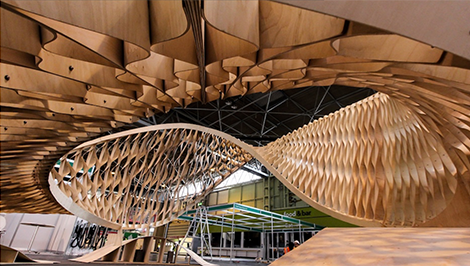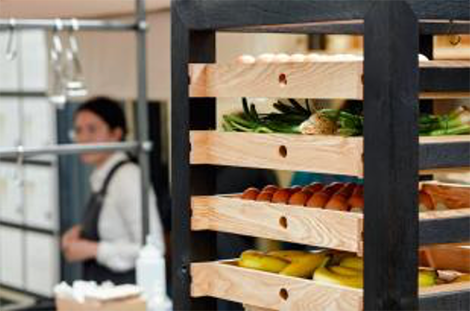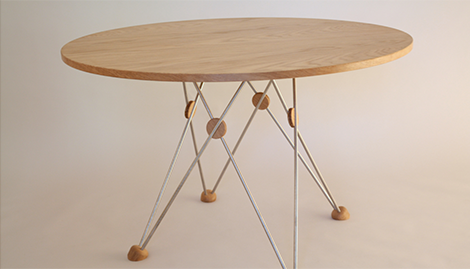
Winner of the Small Project award, Twist by Emergent Technologies and Design, Architectural Association
Stepping back from a world of complex composites, 3D printed titanium and injection moulded plastics, wood is still a material of choice for many projects that brings warmth, character, and sustainability to a design – as well as natural forms and strength.
This year’s Wood Awards – the 45th annual event – rewarded designs using the material across the built environment and sculpture as well as products and furniture.
Below are our favourites from the winning product categories – but you can find all the winners here.
Bespoke Design

Pantori was chosen as the Bespoke winner in the Furniture & Product competition. The judges praised how this project makes bespoke furniture accessible, being so rare to see this kind of work in a public space.
Designer: Steph Leake, Intern at Jack Badger Ltd.
Inspired by the Japanese Wabi-Sabi aesthetic that embraces simplicity and naturalness, Pantori is a freestanding pantry larder, created for Japanese crepe eatery, Nojō. A combination of Japanese and English joinery has been used.
The top has been jointed using three way mitres and wedged tenons, the rails are housed dovetails, while the drawers have been housed and nailed with ring shank nails typically used in boat building.
Oak was selected for the frame and flexible straight-grained ash for the woven inner drawers.
Shou Sugi Ban, the traditional Japanese technique of burning timber to preserve it and make it resistant to fire, rot and insects, inspired the scorching on the oak.
Within the drawers, waste sawdust creates a substrate for mushrooms to grown in. Two extra rails allow the positioning of the drawers to be changed while the oak board provides an extra workspace.
Production Made
The judges were so heartened by the quality of this year’s production made pieces that two projects won.

Planks Collection expresses the integrity of the wood used, using it in the most effective way and bringing rationality to its design. The judges felt this would work in a number of interiors and for different users.
Designer: Max Lamb
Planks’ roots lie in the carpenter’s workbench and 17th/18th century English country furniture. The collection (a dining table, bench, shelving, console table and lounge table) promotes utility, strength, durability and economy of material.
Easily accessible storage prevents clutter from gathering on work surfaces. Varying plank sizes have been used for each piece of furniture to minimize waste. Full-width planks are used as the defining feature.
Narrower planks are joined to form structural rails to support the top. Four simple L-shaped legs, structurally strong yet physically light, connect to the side of the box and support the cantilevered top.

The other, equally placed, winner was Stretch Extending Dining Table. The judges were impressed by the way the design pushes the material, and by this elegant solution to a common problem.
Designer: Pengelly Design
The Stretch Extending Dining Table was conceived to use the natural characteristics of formed ply. The form of the laminations enables the top to slide along a very simple metal frame, exposing the extension leaves stored within the table.
First designed in 2003, the original was much smaller and less successful. The re-design in 2015 was based on overcoming issues with the movement of each lamination.
The updated version is significantly larger due to these issues being resolved.
Student Designer
Within this category were two cash prizes; £1,000 for winner and £500 for people’s choice.

Geometry was chosen as the winner of the Student Designer category. The judges said, “This table has its own definite aesthetic. It is solid and it works, using a system that does not involve any screws. It is a robust piece of furniture.”
Designer: Michael Stevenson, Building Crafts College
A modern circular dining table, Geometry’s frame is inspired by molecular geometry, made with contemporary stainless steel rods and contrasting classic oak junctures.
The table top consists of constructional oak veneer and solid oak lipping.

Velo Chair won the Student Designer People’s Choice Award. Throughout the summer and the London Design Festival the public was asked to choose its favourite student design on Twitter.
Designer: Jan Waterston, Rycotewood Furniture Centre
Inspired by the bicycle, the Velo Chair connects body and object by seamlessly wrapping itself around the user. Each surface is hand sculpted.
Ash was selected for its flexibility, allowing the complex curves to be free- form laminated without breaking. The flexibility allows a more comfortable backrest which flexes and moulds around the sitter.






